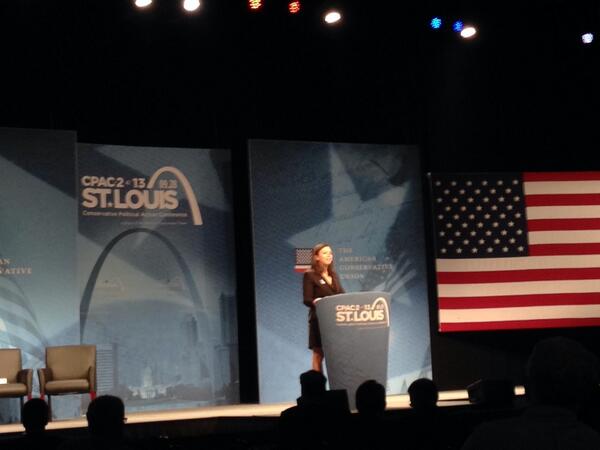This weekend the American Conservative Union held its regional CPAC gathering in St. Louis. Along with several individual speakers, the event included a handful of panels on a range of topics relevant to today’s conservatives. Throughout the day, the various messages conveyed a fusion of conservative and libertarian themes. The trend of mixing libertarian and conservative principles has been building for some time. In Ted Cruz’ recent quasi-filibuster, he mentioned libertarianism several times and yielded the floor to Rand Paul, known for his libertarian leanings. A recent FreedomWorks poll finds that “big tent libertarian values” within the Republican Party and among the American voters in general are at their highest levels in over a decade. There is even a term for the hybridization of the two ideologies: conservatarian.
With these developments, it was the perfect time for a discussion of the dynamic between conservatives–social conservatives in particular–and libertarians. Is there enough commonality for the two groups to unite, or is there too much disparity to fully connect? The issue was discussed and debated during a panel entitled, “Can (Social) Conservatives and Libertarians Ever Get Along?”
Moderating the panel was Tom Minnery, Executive Director of CitizenLink, the public policy affiliate of Focus on the Family. Minnery was an interesting choice for moderator, as his strong social conservatism shone through at many points in the discussion. Three panelists participated in the dialogue: Geoffrey Neale, Chairman of the Libertarian Party; Dr. Matthew Spalding, Vice President of American Studies at The Heritage Foundation (and dead ringer for Ed Helms); and Doug Bandow, Senior Fellow at the Cato Institute.
Minnery started off the discussion with an attempt to explain why social conservatives were hesitant to fully join forces with libertarians. He shared that, in his experience, “social conservatives worry about libertarians’ lack of reverence to our duty to our fellow man” as they seem more concerned with individual freedom. Minnery went on to say, “A free country has got to be led by free people who have within them a moral gyroscope to help them do not only what they must but what they ought” and that social conservatives believe “liberty is a gift from God”.
Geoffrey Neale then interjected, lamenting that “in Washington it is becoming difficult to distinguish between Republicans and Democrats” as their actions are not much different from each other. He opined that, for libertarians, “it is not about left or right, it is about right or wrong”. Responding to Minnery’s claim that it is essential that there be morality within political principle, Neale stated, “Libertarians do a bad job of advertising that we are moral. We just don’t give it a religious source.” The most socially conservative individual on the panel, Minnery added that virtue requires liberty and liberty requires virtue. Bandow shared his own thoughts on the topic of morality and liberty, noting “it is hard to preserve liberty without virtue. We can disagree about the origin of that virtue. We must work together to promote both virtue and liberty.”
Dr. Spalding speaking at CPAC St. Louis
Dr. Spalding agreed that morality is essential to limited government, and agreed with Bandow that the origins of said morality weren’t important despite Minnery’s assertions that they were. Spalding bristled at the question of whether social conservatives were less likely to get along with libertarians than other conservatives, because “once you ask what kind of conservative you are, you immediately divide into groups”. His concern was that division among conservatives and libertarians would only hurt the two movements, emphasizing that “divided we will lose our country and we will not survive the liberal onslaught” that is ongoing and will ramp up with next year’s mid-term elections. While Spalding argued that the Founding Fathers believed in Liberty but were not libertarians, he also stated that today’s government is so big and so bureaucratic it is virtually tyrannical, which is why libertarian viewpoints are rising in popularity. He felt that the two groups coming together would be necessary to take on the opposition.
Doug Bandow also chose to focus on the similarities between conservatives and libertarians. He noted that both “share a commitment to limited government and individual liberty”, going on to say “we have far more in common because we share a common threat, an overarching, abusive State. We must work together. Our differences should allow us to work together, and simply have different focuses.” While he agreed with the previous discussion that is it hard to separate virtue from liberty, he maintained that there is no virtue in coerced actions–“It is hard to imagine a virtuous society without the freedom to make choices.”
Panelist Doug Bandow
In a non sequitur toward the end of the panel discussion, Minnery brought up the topic of “too much casual sex” today leading to more children running around and more foster care being needed, stating that if we wanted more liberty in America we first needed to strengthen the family. None of the panelists agreed; in fact Bandow clarified that Libertarians differ from staunch social conservatives in their belief that not all sins should be against the law. He went on to ask if we really want our leaders telling us which morals to uphold, to which the answer is of course, “No”. Morality cannot be legislated.
Dr. Spalding wrapped up the discussion with his view that the job of government is to create a framework for self-government, and that we cannot limit the government’s powers until we acknowledge that the power of the government is given to it by the people. This was agreed upon by Neale and Bandow. Ultimately, all three speakers had more common ground than they did points of contention. Nevertheless, Dr. Spalding acknowledged, libertarians and conservatives “will always disagree and bicker – that’s what makes it interesting.” CPAC emcee Dana Loesch noted before the panel that the GOP needs to rally around the eighty percent of issues they have in common and worry about the other twenty percent once they’ve actually accomplished something–infighting is not productive. While the most extreme social conservatives lean toward theocratic ideals and extreme libertarians toward anarchy, the vast majority of libertarians and conservatives can come together as they embrace the idea that they are working toward a common objective: limited government and increased liberty.



